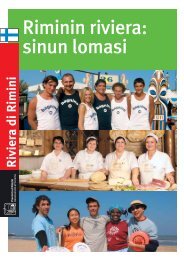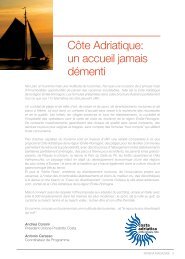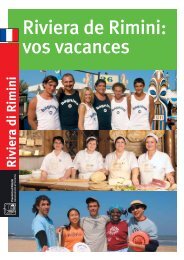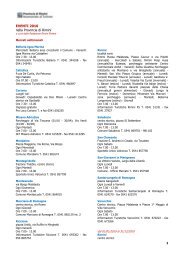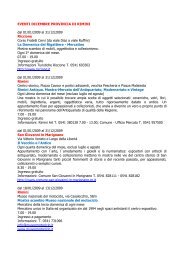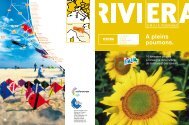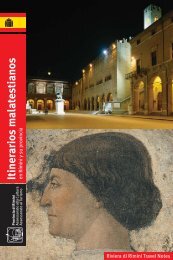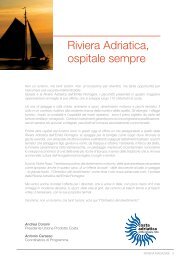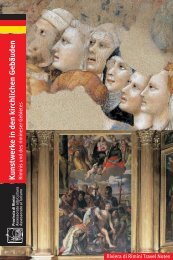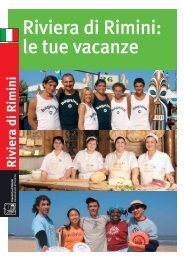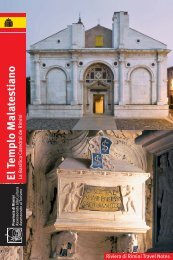You also want an ePaper? Increase the reach of your titles
YUMPU automatically turns print PDFs into web optimized ePapers that Google loves.
fianchi, l’abside e lo svettante<br />
campanile; il rifacimento dell’interno si<br />
deve a Fer<strong>di</strong>nando Bibiena, che la<br />
progettò nel 1720 circa. Affreschi della<br />
scuola riminese del Trecento sono<br />
visibili nella parte bassa del campanile e<br />
nell’abside.<br />
The church, a place of worship for the<br />
Catholic faith, was built around the mid-<br />
13 th century and retains its original<br />
Gothic architecture, sides and apse, as<br />
well as a soaring bell tower. Fer<strong>di</strong>nando<br />
Bibiena planned the restoration of the<br />
interior in around 1720. Frescoes by the<br />
14 th -century <strong>Rimini</strong> school are visible in<br />
the lower part of the bell tower and in<br />
the apse.<br />
• c • g<br />
Castel Sismondo / Sismondo Castle<br />
a piazza Malatesta tel. 0541 351611<br />
(Fondazione Cassa <strong>di</strong> Risparmio)<br />
fax 0541 28660 segreteria@fondcarim.it<br />
www.fondcarim.it<br />
Fatto costruire nel ‘400 da Sigismondo<br />
Pandolfo Malatesta, è superstite il<br />
nucleo centrale. Fu concepito come<br />
palazzo e fortezza insieme, degna sede<br />
per la corte e per la guarnigione e segno<br />
<strong>di</strong> potere e <strong>di</strong> supremazia sulla città. Il<br />
castello è utilizzato per mostre ed<br />
esposizioni.<br />
Commissioned by Sigismondo Pandolfo<br />
Malatesta in the 15 th century, only the<br />
central nucleus remains. It was designed<br />
as a fortress and residence, a seat<br />
worthy of the court and the garrison and<br />
a sign of power and supremacy over the<br />
city. The castle is now used to host<br />
exhibitions.<br />
Ponte <strong>di</strong> Tiberio / Tiberius Bridge<br />
a lato nord / north side<br />
Fu iniziato da Augusto e compiuto da<br />
Tiberio (14-21 d.C.), segna l’inizio della<br />
via Emilia. È in pietra d’Istria ed ha<br />
cinque fornici. Per la sua straor<strong>di</strong>naria<br />
soli<strong>di</strong>tà e resistenza è ancora<br />
appropriato l’appellativo <strong>di</strong> “ponte del<br />
<strong>di</strong>avolo”.<br />
Begun under the rule of Augustus and<br />
completed by Tiberius (14-21 A.D.), it<br />
marks the start of the Via Emilia. It was<br />
built in Istrian stone and has five arches.<br />
Due to its extraor<strong>di</strong>nary soli<strong>di</strong>ty and<br />
resistance its alternative name - “the<br />
devil’s bridge” - is still appropriate.<br />
Arco d’Augusto / Arch of Augustus<br />
a lato sud / south side<br />
Costruito nel 27 a.C. come porta urbica<br />
“onoraria” con decreto del Senato<br />
Romano in onore <strong>di</strong> Cesare Ottaviano<br />
Augusto per aver restaurato la via<br />
Flaminia e le più importanti strade<br />
d’Italia. Oggi si presenta come un<br />
grande arco trionfale, ma in origine era<br />
inserito nelle mura della città. È ad un<br />
solo fornice che per la sua lunghezza<br />
(quasi nove metri) non avrebbe mai<br />
potuto essere chiuso; fatto molto strano<br />
per una porta urbica.<br />
The arch was built in 27 B.C., by order of<br />
the Roman Senate, as an entrance gate<br />
to “honour” Caesar Octavian Augustus<br />
for having repaired the Via Flaminia and<br />
the most important roads in Italy. Today,<br />
it stands isolated, like a large triumphal<br />
arch, but was originally part of the city<br />
walls. It has a single barrel vault that,<br />
due to its length (almost nine metres),<br />
could never have been closed; an<br />
unusual fact for an entrance gate.<br />
Biblioteca Gambalunga<br />
Gambalunga Library<br />
a via Gambalunga, 27<br />
tel. 0541 704486 fax 0541 704480<br />
gambalunghiana@comune.rimini.it<br />
www.comune.rimini.it<br />
Prende il nome dal proprietario<br />
Alessandro Gambalunga che nel 1619<br />
donò con lascito testamentario al<br />
comune sia il Palazzo che la biblioteca.<br />
Scoprire il territorio - Discovering the region<br />
Legenda / Key pag. 6<br />
23




